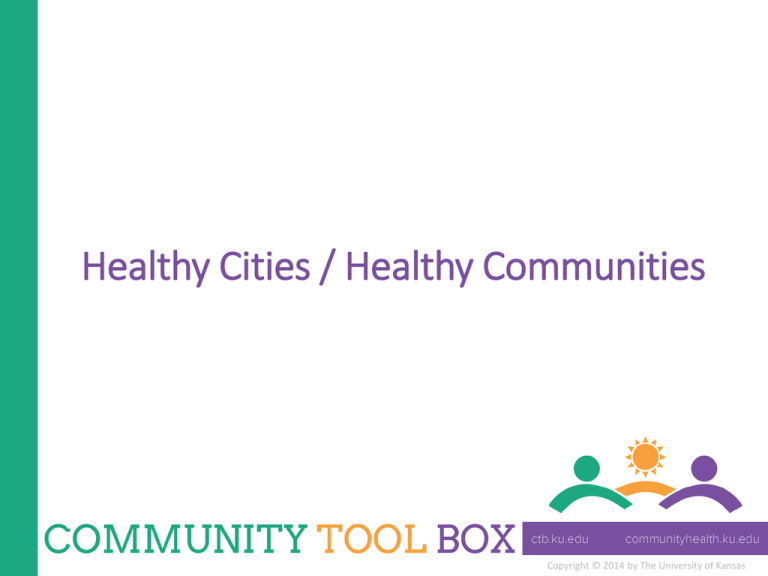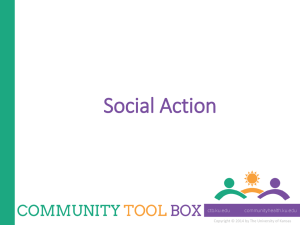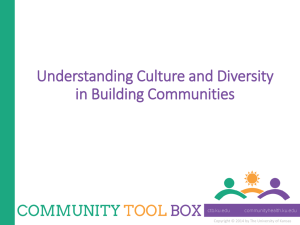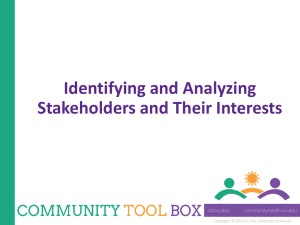Healthy Communities - The University of Kansas
advertisement

Healthy Cities / Healthy Communities Copyright © 2014 by The University of Kansas Healthy Cities / Healthy Communities • A theoretical framework for a process by which citizens can create healthy communities. • Communities where all systems work well and together and where all citizens enjoy a good quality of life. • Loosely-defined strategy that involves all community members addressing issues that are important to them. Copyright © 2014 by The University of Kansas Two Premises of Healthy Cities/ Healthy Communities • A comprehensive view of health. • A commitment to healthy promotion. Copyright © 2014 by The University of Kansas Prerequisites for Health in Communities • • • • • • • • • Peace Shelter Education Food Income Stable ecosystem Social justice Equity Sustainable resources Copyright © 2014 by The University of Kansas How to Promote Community Health • • • • • Build public policy. Create supportive environments. Strengthen community action. Develop personal skills. Re-orient services. Copyright © 2014 by The University of Kansas Community Environments • • • • • • • Natural Economic Leisure Political Work Built Social Copyright © 2014 by The University of Kansas Why use Healthy Cities/Healthy Communities? • • • • • • • • • Community perspective. Participatory planning and community ownership. Range of ideas. Knowledge of the community. Community-wide ties. Achievable and measurable goals Identification and use of community assets and resources. Community self-image. Community commitment to the long-term process. Copyright © 2014 by The University of Kansas Who should participate? • Elected and appointed officials. • Those most affected by the issue. • People who will carry out the initiative or those whose lives will be affected by it. • Agencies and groups involved in implementing the effort. • Community opinion leaders. Copyright © 2014 by The University of Kansas Components of Healthy Cities/ Healthy Communities • • • • • • • • • • Create a compelling vision based on shared values. Embrace a broad definition of health and well-being. Address quality-of-life for everyone. Engage diverse citizen participation and be citizen-driven. Seek multi-sectoral membership in widespread community ownership. Acknowledge the social determinants of health and the interrelationship of health and other issues. Address issues through collaborative problem-solving. Focus on system change. Build capacity using local assets and resources. Measure and benchmark progress and outcomes. Copyright © 2014 by The University of Kansas Three Social Determinants of Health • Socio-economic equality. • Social connectedness. • Sense of personal efficacy. Copyright © 2014 by The University of Kansas Potential Local Assets and Resources • Impassioned individuals with talent, skills, and leadership. • Those with material resources: money, space, etc. • Institutions (libraries, schools, houses of worship…) that can be resources. • Organizations whose mission is to work for a better community. • Official government support along with legal and regulatory powers. • human resources—skills and work ethic. • Natural and other environmental resources. • The potential for these parts to coordinate. Copyright © 2014 by The University of Kansas Steps to Implement a Healthy Community Strategy • Assemble a diverse and inclusive group. • Generate a vision. • Assess the assets and resources in the community that can help you realize your vision, and the issues that act as barriers to it. • Choose a first issue to focus on. • Develop a community-wide strategy, incorporating as many organizations, levels, and sectors as possible. • Implement the plan. Copyright © 2014 by The University of Kansas Steps to Implement a Healthy Community Strategy (cont.) • Monitor and adjust your initiative or intervention. • Establish new systems that will maintain and build on the gains you’ve made. • Celebrate benchmarks and successes. • Tackle the next issues. Copyright © 2014 by The University of Kansas





















